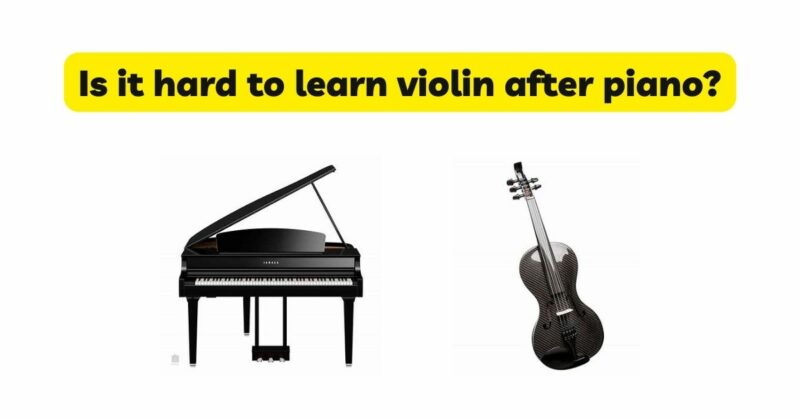Stepping into the world of music often means embarking on a lifelong journey of learning and mastering multiple instruments. For those who have already acquired piano skills, the allure of the violin can be particularly strong. However, the question arises: Is it hard to learn the violin after mastering the piano? In this article, we will explore the challenges and unique aspects involved in transitioning from piano to violin, shedding light on the difficulties one may encounter, as well as the advantages gained from previous musical training. By delving into these aspects, we aim to provide a comprehensive analysis of the complexities and rewards of learning the violin after acquiring piano proficiency.
Technical Differences:
The piano and violin are fundamentally different instruments, each with its own set of technical challenges. The piano requires the pianist to press keys to produce sound, whereas the violinist must learn to manipulate a bow across the strings to create sound. This shift from striking keys to drawing a bow can be initially challenging for pianists, as it demands a new level of physical coordination and control. Furthermore, the violin’s fretless fingerboard introduces the need for precise finger placement to achieve accurate intonation, a skill not emphasized in piano playing. These technical differences can make the transition to the violin a daunting task.
Bowing Technique:
Mastering bowing technique is one of the most critical aspects of violin playing. Pianists accustomed to creating sound solely through the act of pressing keys may find the bowing technique to be particularly challenging. Bowing requires a sensitive touch, control over bow speed, pressure, and contact point, all while maintaining a consistent and even tone. Developing these bowing skills can take time and dedicated practice. Pianists transitioning to the violin must approach bowing technique as a separate and essential aspect of their learning journey, understanding that it may require additional effort to achieve proficiency.
Finger Placement and Intonation:
The violin’s fretless fingerboard demands precise finger placement and intonation. While piano players are accustomed to fixed pitch reference points, violinists rely on the placement of fingers in specific positions along the fingerboard to produce accurate pitches. This shift from the fixed keys of the piano to the fingerboard of the violin requires a heightened sense of pitch and intonation. Pianists transitioning to the violin may face challenges in developing the muscle memory and finger coordination necessary to achieve the correct finger placements consistently. However, with focused practice and attention to detail, these difficulties can be overcome.
Physical Adjustments and Posture:
Transitioning from piano to violin also necessitates adjustments in physicality and posture. Pianists are accustomed to a seated position, while violinists stand, holding the instrument against the shoulder and chin. This change in posture can lead to a period of adjustment and the development of new muscle memory. Proper positioning of the left hand and arm, as well as maintaining balance with the violin, require careful attention. Additionally, violinists must learn to hold the bow correctly, adapting to its weight and balance. These physical adjustments can be initially challenging but can be overcome with consistent practice and guidance.
Musical Expression and Interpretation:
Both the piano and violin offer vast possibilities for musical expression, but their approaches differ due to the nature of the instruments. Pianists have the advantage of playing multiple notes simultaneously, allowing for rich harmonies and complex textures. Violinists, on the other hand, focus on creating expressive melodies and utilizing techniques such as vibrato, bow articulation, and dynamics to convey emotions. Pianists transitioning to the violin must adapt to the violin’s narrower range of notes and explore new ways of expressing themselves through the limitations and unique qualities of the instrument. While this adjustment may present a challenge, it also opens up opportunities for artistic growth and exploration.
Advantages from Piano Background:
Despite the challenges involved, pianists who transition to the violin have certain advantages rooted in their piano background. They bring with them a solid foundation in music theory, including knowledge of scales, key signatures, and notation. This theoretical knowledge can expedite the learning process and facilitate understanding the structure and patterns in music. Additionally, piano players often possess developed finger dexterity, hand-eye coordination, and aural skills, which can be applied to violin playing. While the technical aspects may differ, these transferable skills provide a valuable head start in the learning process.
Dedication and Mindset:
Transitioning from piano to violin requires a dedicated mindset and a commitment to learning a new instrument. Recognizing that the violin presents unique challenges and approaching the learning process with patience and perseverance is essential. Seeking guidance from a qualified violin teacher experienced in teaching pianists can greatly aid in navigating the transition. Regular and focused practice is key to overcoming the difficulties and building proficiency on the violin. With time, dedication, and a positive mindset, pianists can embark on a fulfilling journey of mastering the violin.
Conclusion:
Learning the violin after mastering the piano presents a set of challenges and adjustments that should not be underestimated. The technical differences, particularly in bowing technique and finger placement, can make the transition initially difficult. However, pianists bring valuable skills such as music theory knowledge, finger dexterity, and aural abilities that can facilitate the learning process. With dedication, proper guidance, and a willingness to embrace the unique aspects of the violin, pianists can successfully navigate the transition and embark on a rewarding musical journey. The opportunity to explore the distinctive qualities and expressive potential of the violin is an exciting endeavor that can enrich a pianist’s musical development.


